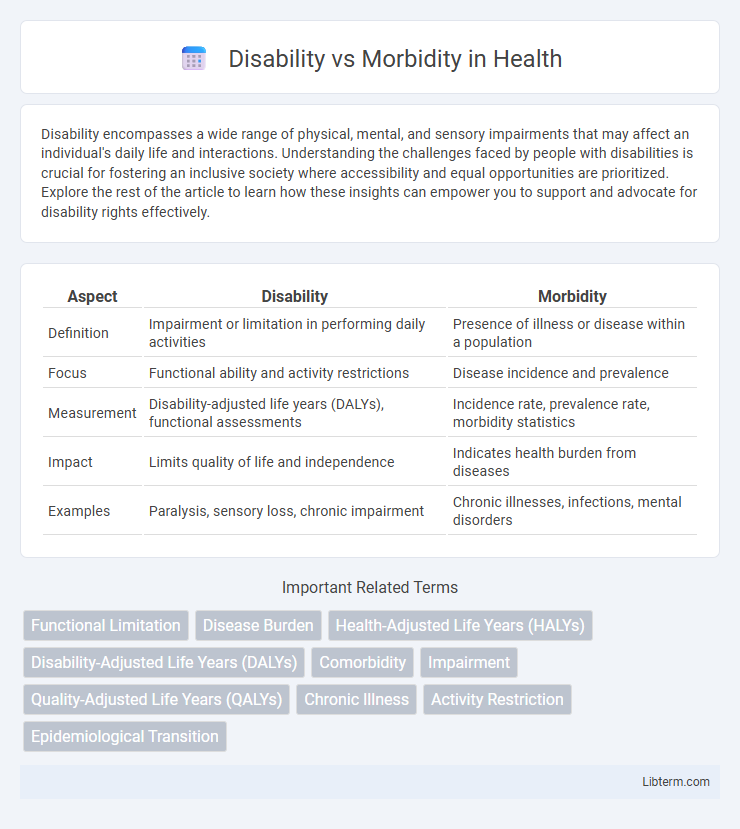Disability encompasses a wide range of physical, mental, and sensory impairments that may affect an individual's daily life and interactions. Understanding the challenges faced by people with disabilities is crucial for fostering an inclusive society where accessibility and equal opportunities are prioritized. Explore the rest of the article to learn how these insights can empower you to support and advocate for disability rights effectively.
Table of Comparison
| Aspect | Disability | Morbidity |
|---|---|---|
| Definition | Impairment or limitation in performing daily activities | Presence of illness or disease within a population |
| Focus | Functional ability and activity restrictions | Disease incidence and prevalence |
| Measurement | Disability-adjusted life years (DALYs), functional assessments | Incidence rate, prevalence rate, morbidity statistics |
| Impact | Limits quality of life and independence | Indicates health burden from diseases |
| Examples | Paralysis, sensory loss, chronic impairment | Chronic illnesses, infections, mental disorders |
Understanding Disability: Definitions and Scope
Disability encompasses physical, mental, intellectual, or sensory impairments that hinder an individual's ability to perform daily activities and participate fully in society. Unlike morbidity, which measures the prevalence and incidence of diseases or health conditions, disability focuses on the functional limitations and societal barriers faced by individuals. Understanding disability requires recognizing its broad scope, including both congenital and acquired impairments, as well as environmental and attitudinal factors that exacerbate challenges.
Morbidity Explained: Meaning and Measurement
Morbidity refers to the presence and extent of diseases or medical conditions within a population, capturing both incidence and prevalence rates to measure health status. It is quantitatively assessed using metrics such as incidence rate, prevalence rate, and severity indices, which provide detailed insights into the burden of illness. Unlike disability, which emphasizes functional limitations and impairments, morbidity focuses on the occurrence and impact of diseases affecting an individual's overall health.
Key Differences Between Disability and Morbidity
Disability refers to the functional limitations or impairments that affect an individual's ability to perform daily activities, whereas morbidity describes the presence of diseases or medical conditions in a population. Disability emphasizes the impact of health problems on physical, mental, or social functioning, while morbidity quantifies the incidence or prevalence of diseases. Understanding the distinction helps in designing targeted healthcare interventions and policy planning to address both functional impairments and disease burdens.
Common Causes of Disability
Common causes of disability include musculoskeletal disorders, neurological conditions, chronic respiratory diseases, and mental health disorders. Musculoskeletal issues like arthritis and back pain contribute significantly to long-term disability worldwide. Neurological disorders such as stroke and multiple sclerosis also rank among leading causes, impacting mobility and cognitive function.
Common Causes of Morbidity
Common causes of morbidity include chronic diseases such as diabetes, heart disease, respiratory infections, and mental health disorders, which significantly impact individual health and healthcare systems. Morbidity refers to the presence of illness or disease, contrasting with disability which denotes limitations in functioning or activities. Understanding morbidity's epidemiology helps target preventive measures and improve disease management to reduce overall health burdens.
Disability Metrics: DALY and Beyond
Disability metrics such as Disability-Adjusted Life Years (DALYs) quantify the overall disease burden by combining years of life lost due to premature mortality and years lived with disability. Beyond DALYs, other measures like Quality-Adjusted Life Years (QALYs) and Years Lived with Disability (YLDs) provide nuanced insights into population health by capturing the severity and impact of non-fatal health outcomes. These metrics are essential for public health planning, resource allocation, and evaluating the effectiveness of interventions targeting both disability and morbidity.
Morbidity Rates: Tracking Population Health
Morbidity rates measure the prevalence and incidence of diseases within a population, providing critical data for public health surveillance and resource allocation. Tracking morbidity rates enables health professionals to identify trends, assess the effectiveness of interventions, and prioritize healthcare initiatives targeting chronic illnesses, infectious diseases, and mental health conditions. Unlike disability metrics that focus on functional limitations, morbidity rates emphasize the occurrence and impact of health conditions influencing population health management strategies.
Social and Economic Impacts of Disability
Disability significantly influences social inclusion and economic productivity, often leading to higher unemployment rates and increased social isolation among affected individuals. The economic burden includes direct costs such as healthcare and rehabilitation, alongside indirect costs like lost income and reduced workforce participation. Addressing barriers to accessibility and implementing inclusive policies can mitigate these social and economic impacts, promoting equitable opportunities for people with disabilities.
Managing Morbidity: Prevention and Care Strategies
Effective management of morbidity involves comprehensive prevention strategies such as vaccination, early screening, and lifestyle modifications to reduce disease incidence and progression. Integrating multidisciplinary care approaches, including chronic disease management programs and patient education, enhances quality of life and mitigates long-term disabilities. Prioritizing access to healthcare resources and continuous monitoring supports timely interventions, minimizing morbidity-related complications.
Disability vs Morbidity: Policy Implications and Future Directions
Disability and morbidity represent distinct yet overlapping public health challenges, with disability indicating functional limitations and morbidity referring to the incidence of disease. Policy implications require integrated strategies that address prevention, rehabilitation, and long-term support to mitigate societal and economic burdens. Future directions emphasize the development of data-driven frameworks and inclusive healthcare systems that prioritize both health outcomes and quality of life for affected populations.
Disability Infographic

 libterm.com
libterm.com